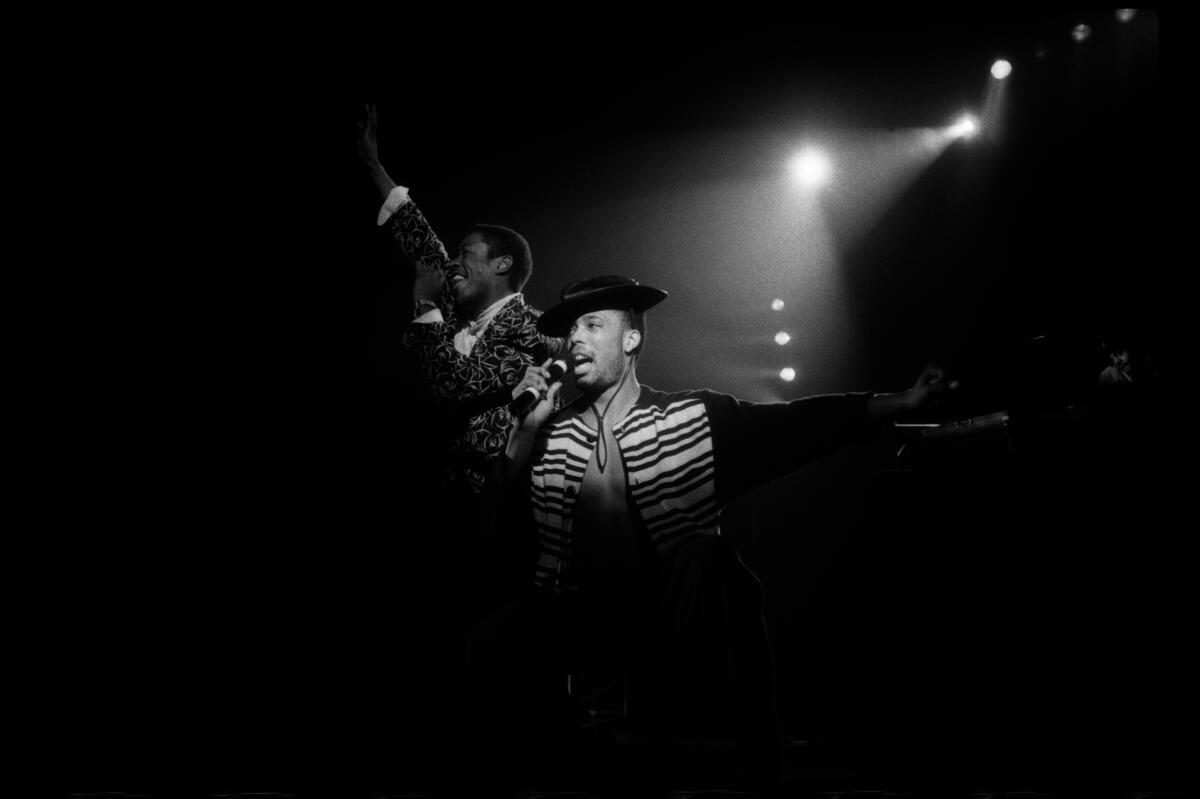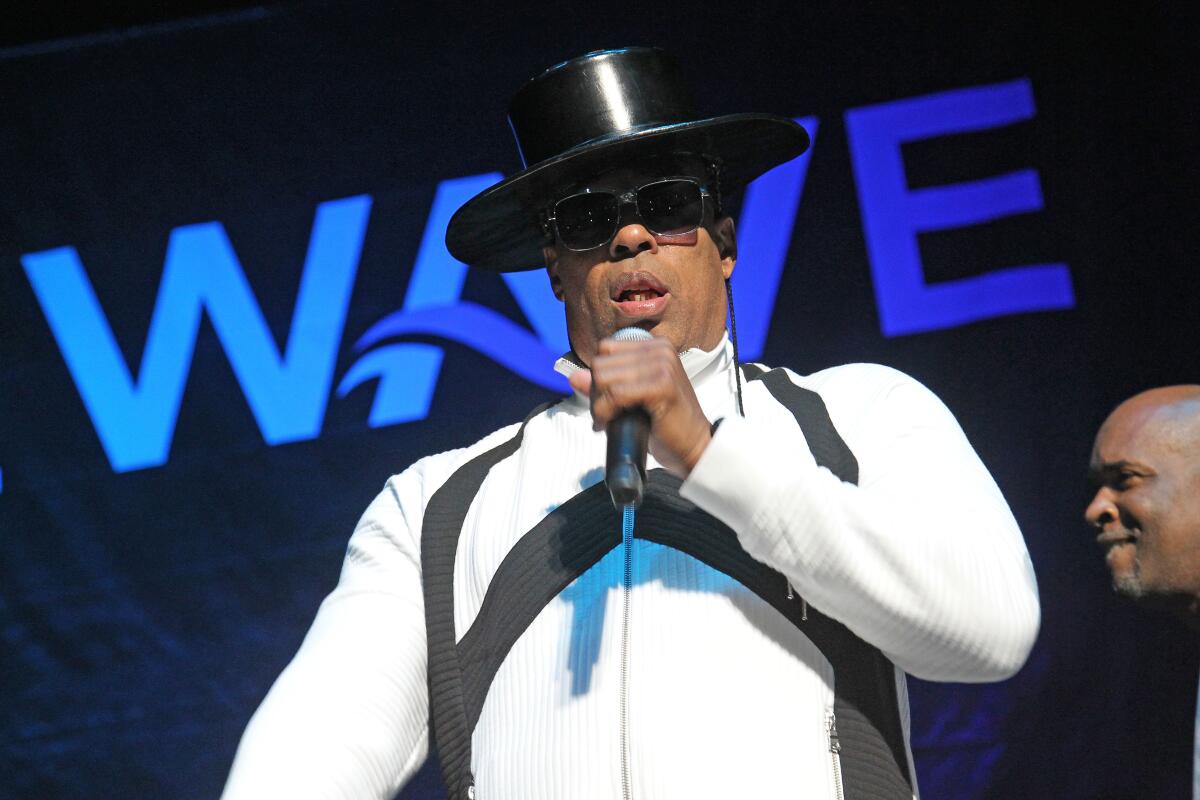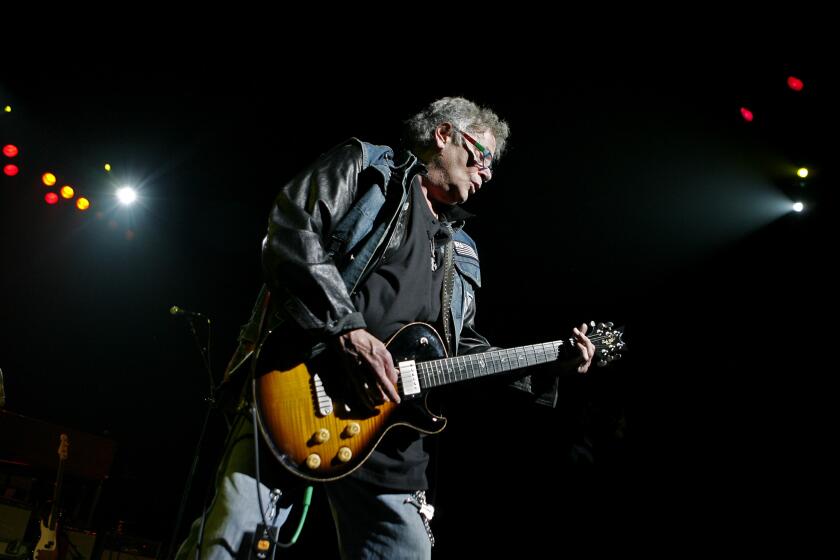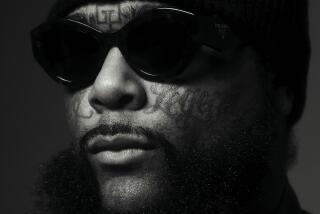Whodini rapper John ‘Ecstasy’ Fletcher, hip-hop pioneer, dies at 56

- Share via
John “Ecstasy” Fletcher, cofounder of the early New York hip-hop group Whodini, who used electro-funk and R&B influences to expand the new genre into a commercially potent force, died Wednesday at age 56.
The cause of death was not immediately known.
“The African and Native American ancestors have gathered around and chosen this day, during the Winter Solstice, Dec 23rd, 2020 to call upon a most endeared, generous, and sincere soul,” Fletcher’s daughter Jonnelle wrote in a statement.
“‘One Love’ to one of Hip Hop’s Greatest! There will never be another,” his bandmate Jalil Hutchins added.

Fletcher was born in Brooklyn and grew up in the neighborhood’s Wyckoff projects. Whodini came of age in the late ’70s and early ’80s, alongside Grandmaster Flash and the Furious Five, Afrika Bambaataa and Kurtis Blow, some of the first acts to take an emergent hip-hop culture of DJ-driven street parties and gain notice in the wider music industry. Whodini’s sound — synth-driven with a hook-heavy mix of singing and rapping — would influence generations of acts and become prime sample material for Dr. Dre, Kanye West, Nipsey Hussle and Nas.
“This man was legendary and a pivotal member of one of the most legendary groups in hip hop,” the Roots’ Questlove wrote Wednesday after news of Fletcher’s death.
Hard-rock progenitors Mountain performed at Woodstock and were best known for co-founder Leslie West’s guitar riff on its biggest hit, “Mississippi Queen.”
Fletcher cofounded Whodini in Brooklyn in 1982 with singer-rapper Hutchins (DJ Drew “Grandmaster Dee” Carter joined a few years later). In his trademark wide-brimmed hat, Fletcher was the immediately recognizable face of the trio.
“Rap needed some sex symbols,” he told The Times in 1987. “There was really nobody out there making the girls go crazy. The girls might like LL [Cool J] some, but I’m talking about a real, honest-to-God sex symbol. That’s us.”
The group signed to the influential London-based label Jive and released what was arguably the first-ever hip-hop music video for its single “Magic’s Wand,” which hit No. 11 on Billboard’s Dance Club charts.
“Jalil showed up with some guy named Ecstasy. [Jive] had no money and no contract for him, but [we] threw the rule book out the window when we heard his verse and his voice,” wrote Barry Weiss, the Jive executive who signed them. “We came up with the name Whodini, threw caution to the wind and watched as these two kids out of Brooklyn conquered the world and set the pace and tone for a generation of rappers that came after them.”
Their early collaborators were an eclectic mix of new wave and experimental rock figures such as synth-pop hitmaker Thomas Dolby and Kraftwerk producer Conny Plank, along with Larry Smith, a major figure behind the boards for Run-D.M.C.
Florian Schneider, the co-founder of Kraftwerk, the German electronic group that changed the sound of pop music, has died of cancer.
“I heard somebody rap one day and I said to myself, ‘I can do that,’” Fletcher told The Times. “I rap in pitch. I try to be unique. I have my own style. I know some people say all rap sounds the same, but there are many differences. People who say that don’t listen to rap carefully enough. If they listen to me, they’ll know I’m unique.”
The trio had its most acclaimed LP in 1984 with “Escape,” a genre-busting album that helped expand hip-hop’s audience while sowing seeds for dance and electronic music as well. Singles like the vocodered funk of “Freaks Come Out at Night,” “Five Minutes of Funk” and “Friends,” a barbed and sarcastic view of relationships as the group’s fame ascended, became its most recognizable hits (“Friends”/“Five Minutes of Funk” peaked at No. 87 on the Hot 100, though “Escape” hit No. 35 on the Billboard 200 and went platinum. The group ultimately won two more gold albums.)

Under the helm of then-manager Russell Simmons, who would go on to cofound Def Jam Recordings, Whodini performed on the first major hip-hop arena tour, “Fresh Festival,” alongside Kurtis Blow and Run-D.M.C. Those raucous shows were a crucial test of hip-hop as a nationwide phenomenon. They also helped prove that the genre was not a sonic fad occasionally embraced by pop artists like Blondie but a turning point for Black artists in the post-disco and soul era.
“The trio, along with producer Larry Smith, made the first hip-hop records that black radio embraced,” critic Nelson George wrote in a Twitter post Wednesday.
After 1986’s “Back in Black,” Whodini was the top-billed support act on Run-D.M.C.’s “Raising Hell” tour, listed above then-emerging acts LL Cool J and the Beastie Boys. But the group’s rise coincided with hip-hop’s growing pains in white suburban America. Whodini was onstage at the Long Beach Arena at a 1986 concert with Run D.M.C. where 40 attendees were injured in a riot that spooked some promoters of early live hip-hop.
The next wave of rappers, like Public Enemy’s Chuck D, acknowledged Fletcher’s tutelage and influence.
“1987 I entered the @Defjam tour w PE,” he wrote on Twitter. “I tended to be nervous looking at 15000 fans in front of me every night. There were 2 MCS that directly mentored my calm that summer. 1 was@RealDougEFresh the other was Ecstacy of Whodini. Always there to reassure w advice [and] tips.”

Although the group’s sound would wax and wane in fashion over the decades to come (its last album, “Six,” came out in 1994), scores of artists from the New Jack Swing, gangsta rap and contemporary era cited Whodini through samples, and it was a clear influence on acts like the Weeknd and Tyler, the Creator, who have looked to the ’80s for retro-futurist inspiration.
The group’s ’80s and ’90s peers weighed in on the trio’s profound impact after news of Fletcher’s death. On Instagram, LL Cool J called Fletcher “one of the most important people in this culture to me,” and producer Jermaine Dupri posted, “My God, this one hurts me so bad, I can’t even believe I’m posting this, Ex you know I love you.”
Dupri, who briefly worked with the group as a backup dancer, produced “Six” and cited Whodini as a formative influence on his top-selling work with TLC.
Whodini continued to tour on the classic-rap nostalgia circuit and received awards at VH1’s Hip Hop Honors in 2007 and Black Music Honors in 2018.
Jonnelle Fletcher said in her statement that “John ‘Ecstasy’ Fletcher was a beloved man, the life partner to Deltonia and ex-husband to Carla, twin brother to Joseph, artist, friend, and lifetime performing partner to the Legendary Jalil of Whodini.”
“We’re good — real good,” Fletcher told The Times in 1987. “I don’t want to sound like a braggart. I’d rather have somebody else give us credit. But the truth is the truth.”
More to Read
The biggest entertainment stories
Get our big stories about Hollywood, film, television, music, arts, culture and more right in your inbox as soon as they publish.
You may occasionally receive promotional content from the Los Angeles Times.












